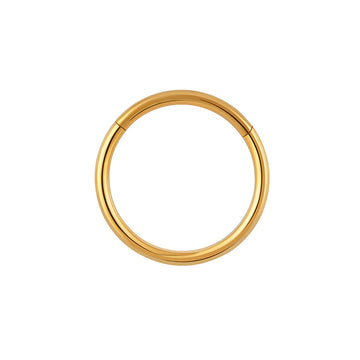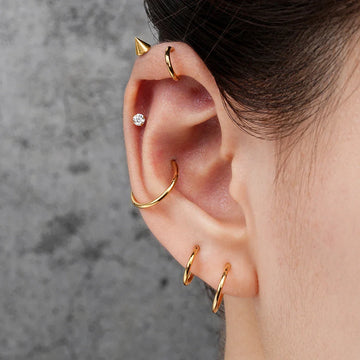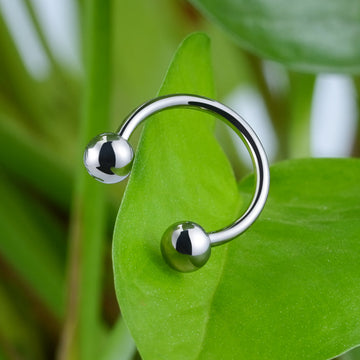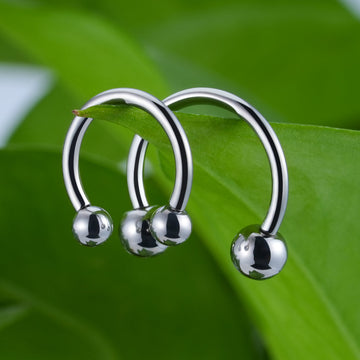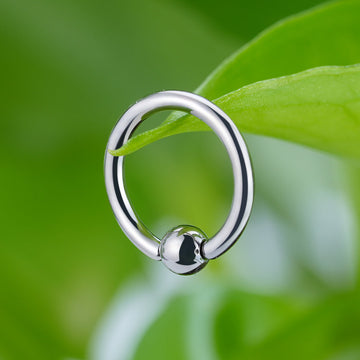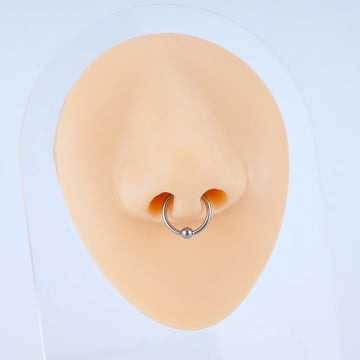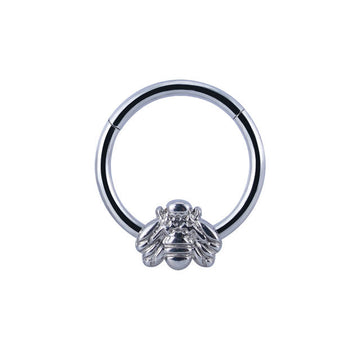Types of Septum Rings: Pros, Cons, Sizes, and Metals
Sep 23, 2024
Septum piercings have become more and more popular, especially as celebrities have been sporting septum jewelry. They go through your septum, which is the thin wall of cartilage between your nostrils. The piercing will go in the soft area just below your septum.
There are many types of Septum rings. They are often made out of implant-grade titanium, surgical stainless steel, and 14-karat or 18-karat solid gold. They also come in many different shapes and designs so you can find the jewelry that best suits your style and personality.
Types of Septum Rings: Pros and Cons
You can use a wide variety of nose jewelry for Septum nose piercings. The most common types of Septum rings are horseshoe barbells (circular barbells), septum clickers (segment clicker rings), captive bead rings, and seamless rings.
You can also go with a fake Septum piercing if you want to avoid the pain and risks of nose piercings.
1. Horseshoe Barbells (Circular Barbells)
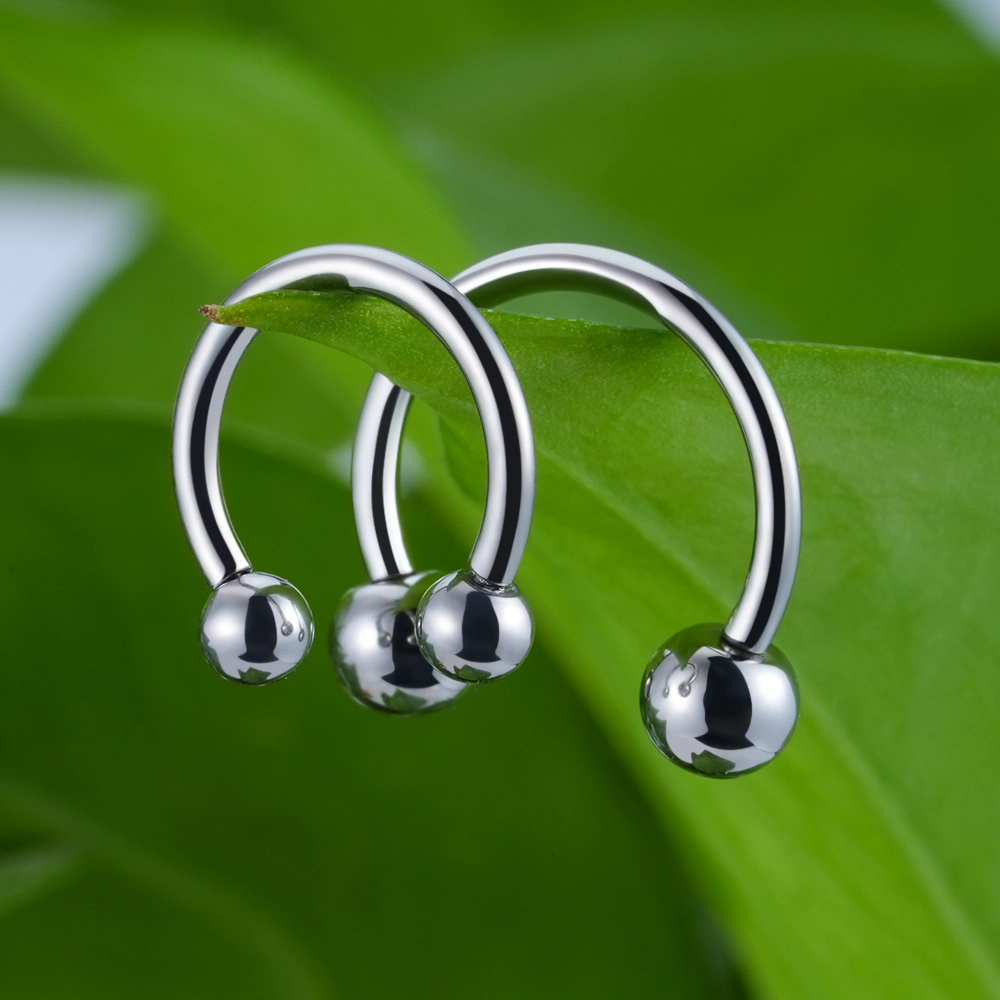
Titanium nose ring curved barbell horseshoe 5 pcs $29.9, SHOP NOW.
Horseshoe barbells are the most popular choice among all types of Septum rings. They have a curve that takes the shape of an arch with two balls on either end. You can go with a traditional round bead or opt for other shapes and accents.
These barbells are sometimes called "horseshoe Septum piercing" because they look like horseshoes.
Pros:
- Barbell jewelry can be a great statement piece and can stand out
- The curved shape can make Septum piercings more comfortable
- They are available in a very wide variety of designs
Cons:
- They may not be the best option if you’re looking for something subtle
- They also may get caught easily on items like clothing.
2. Captive Bead Rings
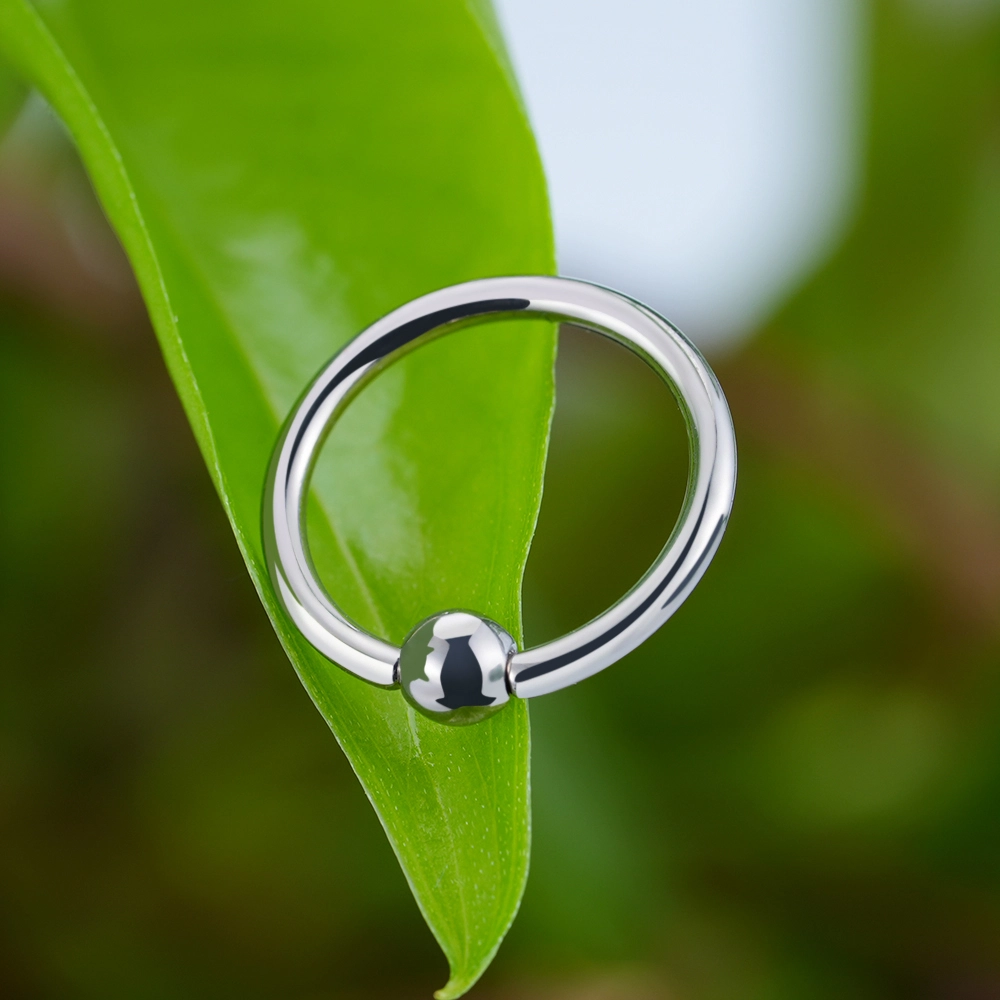
16 gauge captive bead nose ring made of implant grade titanium $19.9, SHOP NOW.
Captive bead rings (CBRs) are a traditional choice for a Septum piercing. CBRs are a full circle with a bead closing the loop. You can replace the bead with a pearl, birthstone, or another unique style. They are popular, coordinating easily with other pieces of jewelry.
Pros
- CBRs are bold and trendy
- They are easy to use.
- They’re also less likely to get caught on clothing because of their closed design.
- They usually remain securely in place
Cons
- Captive bead rings can be very hard to close
- You may not enjoy it if you want a subtle piercing.
3. Septum Clickers (Segment Clicker Rings)

Nose piercing clicker titanium septum ring 16G in gold and silver $22.9, SHOP NOW.
Septum clickers take the shape of a loop but have a hinged design that opens and closes. You unhinge the clicker, insert it through your nose, then close the hinge. Clickers may be a simple loop, have a dangling chain, or showcase a collection of gemstones. Septum clickers are easy to put in and look amazing!
Pros
- Septum clickers are comfortable
- They are easy to put in and take out with
- There are many designs to choose from
- They’re also less likely to get caught on clothing because of their closed design.
- They usually remain securely in place
Cons
- You have to securely click the jewelry closed to ensure it doesn’t fall out
- It may feel bulkier than other options because of the hinged design
4. Seamless Rings

14K gold nose ring hoop seamless ring $89.9, SHOP NOW.
Rosery Poetry 14K gold septum piercing ring simple and minimalist $34.9, SHOP NOW.
When shopping for Septum jewelry, you may come across “classic” Septum nose rings or seamless rings. When they are inserted properly, they create a complete, closed shape. They may be a complete circle, or they may take other fun shapes like a heart, moon, or oval.
There is no bead or latch visible for a seamless look. They are typically just a metal hoop, which is ideal if you're looking for something simple. They are the most minimalist among all types of septum rings.
Pros
- They are classic and timeless
- They offer a clean look without the need for additional hardware.
- They’re also less likely to get caught on clothing because of their closed design.
- They usually remain securely in place
Cons
- They may be too plain for your taste.
- Thin hoops can be bent very easily
- Seamless rings can be hard to insert at first
- You may need to be careful to avoid distorting the shape as you open and close the jewelry.
5. Crescent Pinchers
Crescent pincers are crescent-shaped with a design that is thick in the center and tapers down into points. The jewelry is held in place with an O-ring on either side of the septum. Crescent pincers offer a dramatic look and may require you to stretch your piercing hole to accommodate the size of the jewelry.
Pros
- Crescent pincers allow you to create a dramatic look and showcase your septum piercing.
Cons
- Pincers can require stretching, so you may not be able to wear them immediately.
- The O-rings may also take extra work to secure the jewelry.
7. D-Shape Rings
D-shaped Septum rings are just like they sound. They form a D shape with the flat part going through your septum and the curved part hanging down from your nose. You may need to bend the D ring to open and close it, or there may be a latch. They also come in both plain and bold designs.
Pros
- D rings provide a simple design
- They are comfortable
- They are secure
Cons
- D-shaped septum rings may be difficult to open and insert, especially if you’re new to using them.
8. Septum Retainers
Septum retainers are meant to keep your piercing hole open without drawing attention. They can be titanium, steel, glass, or acrylic. Glass, acrylic, and other clear materials are often a favorite if you’re trying to hide a piercing. Septum retainers are usually shaped like a staple and can be flipped up or down with a snug, secure fit.
Pros
- Septum retainers help prevent your hole from closing and
- are a discreet option.
Cons
- Retainers may not be as comfortable with their snug fit,
- and they aren’t decorative if you’re looking for a statement piece.
9. Fake Septum Piercing
If you’re not quite ready to make the commitment to a Septum piercing, you can opt for a fake Septum ring. They still come in a variety of shapes, sizes, and designs, but instead of going through your nose cartilage, they clamp onto your septum.
You simply open the fake piercing up, position it where you want it, and push the ring closed until it’s secured on your nose.
A fake Septum piercing is a great choice if you want to avoid the pain and risks of nose piercings.
Pros
- With fake Septum rings, you can explore different types of Septum rings and get the feel for a Septum piercing before making the commitment.
Cons
- Fake Septum rings aren’t the real deal, so you may not get the full experience of a real piercing.
- You may also experience pinching or discomfort with the fake ring pinched onto your septum.
What Types of Septum Rings Should You Get?
If you’re considering getting a Septum piercing, be sure to explore all of your options and take a close look at all types of septum rings.
First, think about what type of metal you'd like. Consider any skin allergies you may have and think about what other types of jewelry you typically wear.
Second, browse through various types of Septum rings, including hoops, barbells, clickers, pincers, and more to find the design that best showcases your personality.
Standard Sizes for All Types of Septum Rings
When it comes to septum ring sizes, we need to consider 2 elements: gauge (thickness of the post) and diameter (size of the ring).
What are the standard Septum ring sizes? As shown below, the standard Septum piercing size is 16 gauge (1.2 mm) for thickness and 8 mm (5/16") for diameter.
| Septum ring sizes chart | Gauge (Thickness) | Diameter (Hoop size) |
| The standard size | 16 gauge (1.2 mm) | 8 mm (5/16") |
| Also available in | 18 gauge (1 mm) | 10 mm (3/8"), 12 mm (1/2") |
Safe Materials for All Types of Septum Rings
One of the most important factors in the healing process of nose piercings is the material you choose. If you're considering a nose piercing, here are some of the safemetals for Septum piercings.
1. Implant-Grade Titanium

Diamond nose ring 16g titanium with CZ $22.9, SHOP NOW.
Titanium is an element that is completely hypoallergenic, so it's probably the best material for nose rings, especially if you have sensitive skin.
Implant-grade titanium is the purest form and will not change or corrode if it's exposed to skin or bodily fluids. Implant-grade titanium jewelry is durable, hypoallergenic, and non-corrosive.
Price Range: About $10-$20.
Pros:
- Approved by the Association of Professional Piercers
- Won't cause allergic reactions
- Is scratch-resistant and won't fade
Cons:
- Not as valuable as gold, silver, or platinum
- Doesn't sparkle quite as much as other metals
2. 14-Karat or 18-Karat Gold

14K gold hoop with an opal pendant segment clicker nose ring $146.9, SHOP NOW.
If you're looking for a glittering, valuable metal for your nose jewelry, either 14-karat or 18-karat gold may be your answer.
It is also one of the best metals for nose rings that are highly recommended not only by piercing experts but also doctors. Its excellent quality of being inert makes it suitable for first piercings.
However, gold is a fairly soft metal, so it doesn't stand up to scratches and excessive wear. Compared to 14-karat gold, 18-karat gold is more prone to being affected by everyday use as it is softer and is closer to being pure 24-karat gold.
Both of these metals include other metal types in order to make them stronger. In order to avoid skin reactions, look for nickel-free metals.
Price Range: About $30-$200.
Pros:
- One of the most valuable materials
- Will not easily tarnish
- Offers plenty of sparkles
- Is easy to engrave or use to set stones
Cons:
- May contain non-hypoallergenic metals
- 18K gold in particular is not very scratch resistant
3. Surgical Stainless Steel
Lots of new piercings are done in stainless steel. This material is affordable and typically doesn't cause reactions. However, even surgical-grade steel contains small amounts of nickel that could cause allergic reactions in those with skin sensitivities.
It is incredibly resistant to corrosion and will keep its shine for years.
If you're considering steel, 316L or 316 LVM steel is probably your best choice. Both names stand for the same surgical steel material, but the "VM" stands for"vacuum melt," or the way the steel is produced.
Price Range: About $10-$40.
Pros:
- Very affordable
- Common enough that you'll have plenty of jewelry choices
- Extremely durable and resistant to damage and corrosion
Cons:
- May cause reactions in those with nickel allergies
- Not considered as valuable as some other materials
Read More
A Complete Guide: Septum Piercing Price, Pain, Healing, Aftercare…
Septum Ring Sizes: What Gauge Is a Septum Piercing?
Rejected Septum Piercing: How to Tell and What to Do?
Nose Rings: 9 Most Common Types of Nose Rings, Studs and Chains





